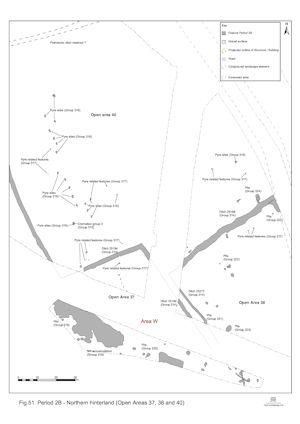
Open Area 37 (Figure 51) is defined to the north-west and north-east by boundary ditches 25194 and 25190 and by the edge/slope of the gravel terrace to the south. This triangular area is perhaps best perceived as a part of the upper terrace that falls outside the new enclosure system laid across it. As such, this (non-)enclosure probably has a marginal character and function. However, a large part of its interior lies outside the excavated areas and much of the activity within it is restricted to pitting, seemingly concentrated on the slope and at the foot of the upper terrace step.

Running along the foot of the gravel terrace slope, at the south of Area W and conjectured to be within OA37, is an extensive rich brown clay silt deposit incorporating a substantial fine gravel component. Deposits 3501, 3763, 3764, 3765 are separate patches, but all are virtually identical and plausibly regarded as part of the same overall material (its fragmentation probably the result of either slightly deeper machining or changes in the level of the underlying topography).
Principal deposit 3501 obscures numerous features below it, and is only excavated around its edges. All the features sealed below it date no later than the late 1st century AD, and the pottery in 3501 is also of this date, although there is also a later knee brooch (SF128). Pit 3507 (Group 913) may also have lain partially below this layer, though its pottery is considerably later in date and this relationship seems curious.
It is likely that this gravelly silt accumulated in a relatively short span of time towards the later 1st century AD. It remains puzzling that such an extensive deposit acquires very few later finds, and is not cut by any later features except in two places. It is tempting to speculate that this is the product of soil creep from areas (slightly upslope) to the north (i.e. to the south of ditch 25194) and to wonder if this signals a specific change in land-use, either the first ploughing of the area to the north, or increased soil mobility owing to loss of grass cover. However, it is probably more likely that some more direct and deliberate human agency must be invoked to account for it. There is little other evidence of a major change in land-use in the area south of ditch 25194. The deposit may be no more than the mixed and spread top fills of the many features below, although during excavation it did seem convincingly to be a separate entity.
Within OA37, Period 2B pits 3525, 3528, 3543 and 3659 (Group 319) and 3513, 3589, 3601, 3606, 3660, 3694, 3698 and 3789 (Group 320) all lie on the slope or at the foot of the upper gravel terrace. All are relatively small and oval to sub-rectangular, and generally between 1.4m and 1.8m wide, and a maximum of 0.5m deep.
Pits 3601 and 3660 contain a lot of pottery, but little else. Small quantities of baked clay and briquetage are present, but an absence of bone perhaps results from the acidic nature of the gravelly soils of the upper terrace.
Isolated pit 2119 (Group 317) is located at the northern end of OA37. However, it is considered to be related to the pyre sites further north, rather than to be an outlier of the pits along the terrace edge, and is therefore described in that section.
Internet Archaeology is an open access journal based in the Department of Archaeology, University of York. Except where otherwise noted, content from this work may be used under the terms of the Creative Commons Attribution 3.0 (CC BY) Unported licence, which permits unrestricted use, distribution, and reproduction in any medium, provided that attribution to the author(s), the title of the work, the Internet Archaeology journal and the relevant URL/DOI are given.
Terms and Conditions | Legal Statements | Privacy Policy | Cookies Policy | Citing Internet Archaeology
Internet Archaeology content is preserved for the long term with the Archaeology Data Service. Help sustain and support open access publication by donating to our Open Access Archaeology Fund.